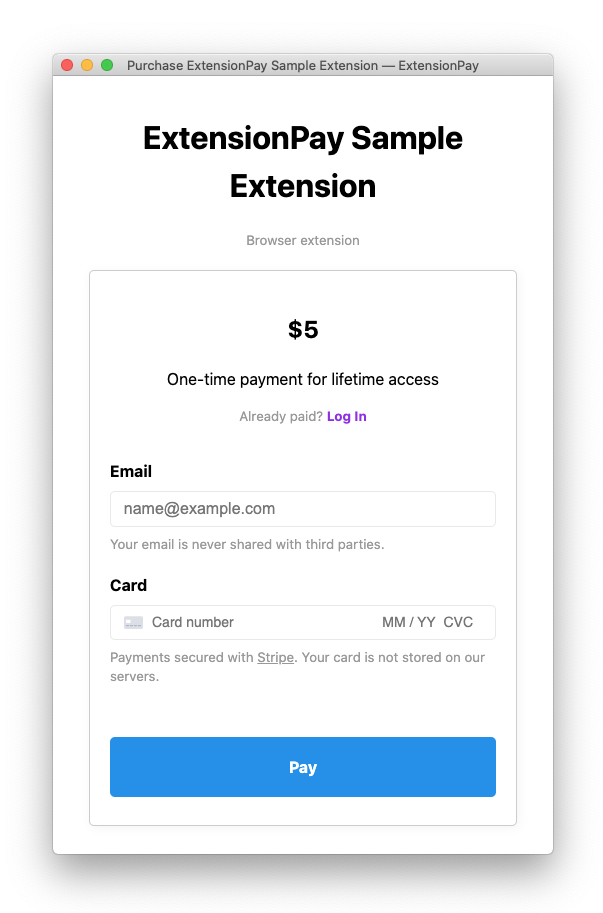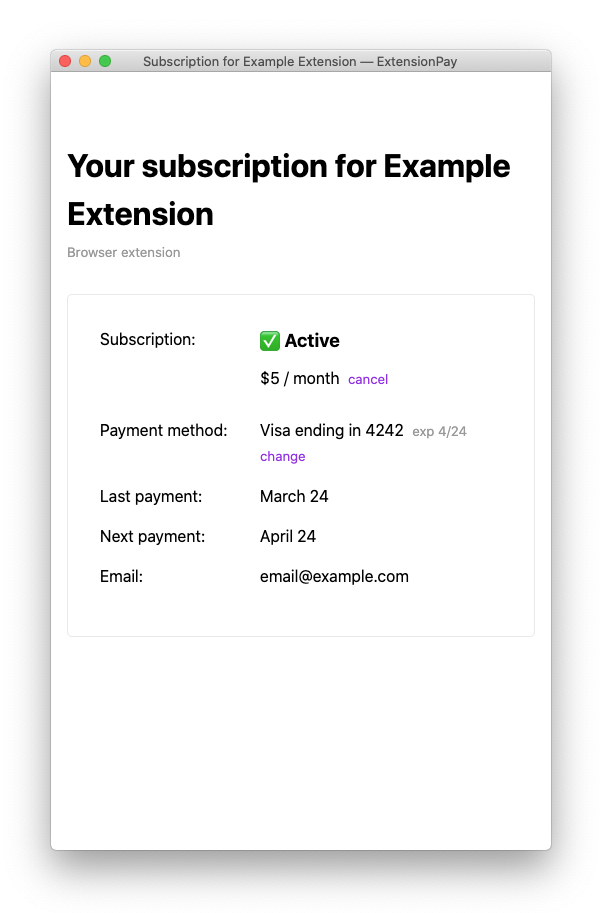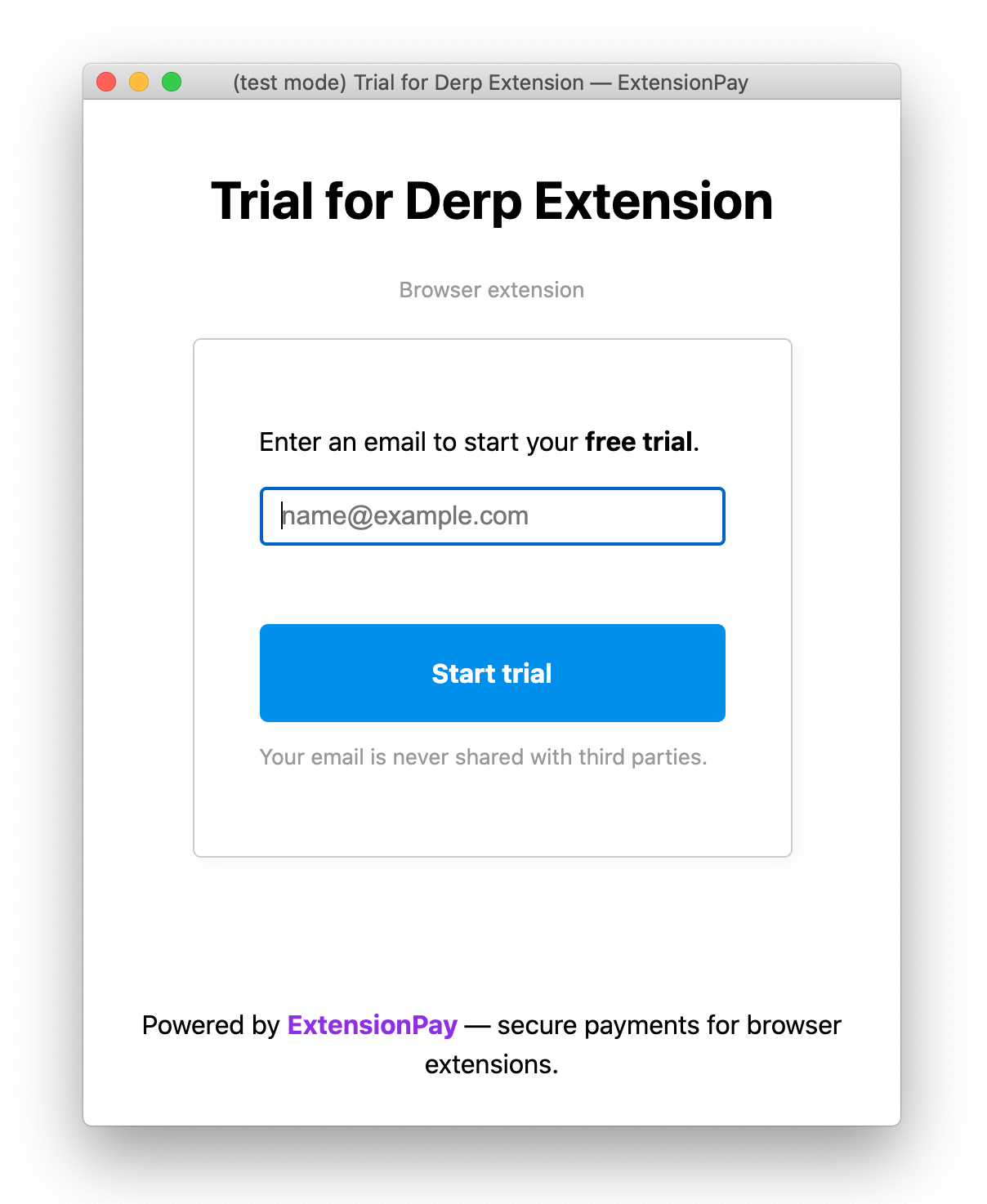The JavaScript library for ExtensionPay.com, a service to easily add payments to browser extensions without running your own server backend.
Below are directions for using this library in your browser extension. If you learn better by example, you can also view the code for a sample extension. This library uses Mozilla's webextension-polyfill library internally for compatability across browsers which means it should work on almost all modern browsers.
- Install
- Configure your
manifest.json - Add
ExtPaytobackground.js(required!) - Use
extpay.getUser()to check a user's paid status - Use
extpay.openPaymentPage()to let the user pay - Use
extpay.onPaid.addListener()to run code when the user pays - Use
extpay.openPaymentPage()to let the user manage their subscription preferences - Use
extpay.openTrialPage()to let the user sign up for a free trial
Note: ExtPay.js doesn't contain malware or track your users in any way. This library only communicates with ExtensionPay.com servers to manage users' paid status.
Copy the dist/ExtPay.js file into your project, or, if you're using a bundler (like Webpack or Rollup):
npm install extpay --saveExtPay needs the following configuration in your manifest.json (for both manifest v2 and v3):
{
"permissions": [
"storage"
]
}ExtPay will not show a scary permission warning when users try to install your extension.
If you have a "content_security_policy" in your manifest or get a Refused to connect to 'https://extensionpay.com...' error, you'll have to add connect-src https://extensionpay.com to your extension's content security policy. See Mozilla's documentation for more details.
You need to put ExtPay in your background file, often named something like background.js. If you don't include ExtPay in your background file it won't work correctly. If you're using a bundler you can import 'ExtPay' or require('ExtPay') right in your background.js.
With either Manifest V3 or Manifest V2 you'll need to sign up and register an extension. When you register an extension you'll create an extension id that you'll use when initializing ExtPay. We'll use sample-extension as the extension id in the following examples.
{
"background": {
"service_worker": "background.js"
}
}// background.js
importScripts('ExtPay.js') // or `import` / `require` if using a bundler
var extpay = ExtPay('sample-extension'); // Careful! See note below
extpay.startBackground(); Note about service workers: In the example above extpay will become undefined when accessed in service worker callbacks. To use extpay in service worker callbacks, redeclare it like so:
chrome.storage.local.get('foo', function() {
var extpay = ExtPay('sample-extension');
// ...
})Make sure not to use extpay.startBackground() in callbacks — it should only be called once.
If you're not using a bundler, add ExtPay.js to manifest.json:
{
"background": {
"scripts": ["ExtPay.js", "background.js"]
}
}// background.js
const extpay = ExtPay('sample-extension')
extpay.startBackground();This method makes a network call to get the extension user's paid status and returns a user object.
extpay.getUser().then(user => {
if (user.paid) {
// ...
} else {
// ...
}
})or use await:
async function foo() {
const user = await extpay.getUser();
if (user.paid) {
// ...
}
}It is possible for extpay.getUser() to throw an error in case of a network failure. Please consider this possibility in your code e.g. extpay.getUser().then(/* ... */).catch(/* handle error */)
The user object returned from extpay.getUser() has the following properties:
| property | description |
|---|---|
user.paid |
true or false. user.paid is meant to be a simple way to tell if the user should have paid features activated. For subscription payments, paid is only true if subscriptionStatus is active. |
user.paidAt |
Date() object that the user first paid or null. |
user.installedAt |
Date() object the user installed the extension. |
user.trialStartedAt |
null or Date() object the user confirmed their free trial. |
| subscription only | |
user.subscriptionStatus |
One of active, past_due, or canceled. active means the user's subscription is paid-for. past_due means the user's most recent subscription payment has failed (expired card, insufficient funds, etc). canceled means that the user has canceled their subscription and the end of their last paid period has passed. You can read more about how subscriptions work here. |
user.subscriptionCancelAt |
null or Date() object that the user's subscription is set to cancel or did cancel at. |
Opens a browser popup where the user can pay to upgrade their status.
extpay.openPaymentPage()The payment page looks like this:
Note: extpay.openPaymentPage() can fail to open the popup if there is a network error. Please consider this possibility in your code.
It is best to open the payment page when the user has a clear idea of what they're paying for.
While testing, use your ExtensionPay email to test payments without entering credit card information. Reinstall the extension to reset back to an unpaid user.
Depending on how you configure your extension, users that have paid before can log in to activate their paid features on different browsers, profiles, or after uninstalling/reinstalling.
If you want to run some code when your user pays, use extpay.onPaid.addListener():
extpay.onPaid.addListener(user => {
console.log('user paid!')
})To use this feature, you will need to include the following content script configuration in your manifest.json:
{
"content_scripts": [
{
"matches": ["https://extensionpay.com/*"],
"js": ["ExtPay.js"],
"run_at": "document_start"
}
]
}The content script is required to enable extpay.onPaid callbacks. It will add a permissions warning when installing your extension. If you're using a bundler, you can create a file called something like ExtPay_content_script.js that only contains import 'ExtPay' or require('ExtPay') and use that in the "js" field above.
You can add as many callback functions as you want.
Note: onPaid callbacks will be called after a user pays as well as after a user "logs in" (e.g. activates their paid account on a different browser/profile/install). This may change in the future -- if you'd like this to work differently, please contact me with a detailed explanation of your use case :)
If your extension is configured for subscription payments, you can let the user manage their subscription from within the extension with the same function you used to let them pay:
extpay.openPaymentPage()The subscription management page looks something like this:
Note: please read the detailed docs on subscriptions here.
If you want to give your users a trial period of your extension, you can use extpay.openTrialPage(), which looks something like this:
The user will be sent an email with a link that they can use to start their free trial. Once the user clicks the link, you can use the trialStartedAt property from extpay.getUser() in your extension to check if the trial has expired.
For example, if you wanted a 7 day trial period, you could use a check like this:
const extpay = ExtPay('sample-extension');
extpay.getUser().then(user => {
const now = new Date();
const sevenDays = 1000*60*60*24*7 // in milliseconds
if (user.trialStartedAt && (now - user.trialStartedAt) < sevenDays) {
// user's trial is active
} else {
// user's trial is not active
}
})Note that extpay.openTrialPage(displayText) takes an optional string argument that is displayed to the user on the trial page. For example, extpay.openTrialPage('7-day') would change the trial prompt from Enter an email to start your free trial to Enter an email to start your *7-day* free trial. This is meant to give your users a better idea of what they're signing up for.
You can also use extpay.onTrialStarted.addListener() to run functions when the user's trial starts. Like onPaid, you need to include the following in your manifest.json to make it work:
{
"content_scripts": [
{
"matches": ["https://extensionpay.com/*"],
"js": ["ExtPay.js"],
"run_at": "document_start"
}
]
}npm install- Edit
ExtPay.dev.js npm run devnpm run distbefore committing changes.


